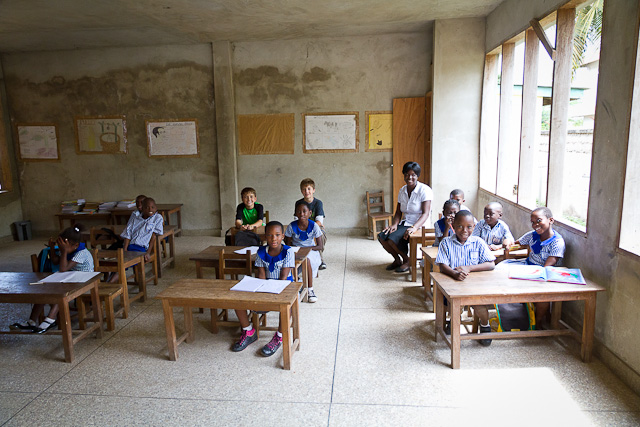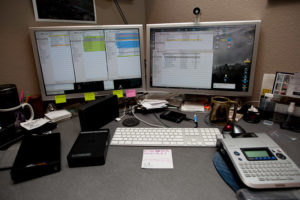Having gotten the contact information of a great taxi driver from one of the faculty who had used him the day prior, we spent the day with Eric, who works at the port as an electrician. Eric was a very nice guy, telling us all about the places we were going, answering our endless questions about life in Ghana. We all packed into his little car, and each time we stopped he made sure we got our belongings out, rolled up all the windows and locked the doors, not the simplest feat. Mid-eighties and probably the same relative humidity this time of year, relatively cool for locals, still dripping-wet hot for us rather parched Coloradans (although I do hear fall has arrived!).
We started the day with the usual quest to find an ATM that worked, which we finally did. Reade and I waited in the parking lot with the car parked abeam the actual parking spots, while Tate, Heidi, and Eric went into the bank. On one side was the bank parking lot with all sorts of people strolling by, the other side some shacks, people also strolling by. At one point the bank security guard came up and indicated that the car needed to be moved, to which I replied “I’m only a passenger, and our taxi driver is inside in a red shirt.” He said something like: “I do not know him personally…” and ambled off. Not too sure what I said to elicit that response, but it is a foreign country, after all.
 |
| Where they make the cornmeal-based ‘banku’; that’s a giant belt-driven mixer back there, not your average Kitchenaide. |
Eric first took us to the Community 1 market. As the city of Tema has grown, it became necessary to delineate the different parts of town not by neighborhood names, but by community numbers, Community 1 being the first, closest to the shoreline. I saw at least eleven named communities. The local markets in Ghana are how practically everyone shops for the everyday staples of life. Like the medinas, they are merely pathways with vendors on each side, though in this case instead of buildings on either side like in Morocco, it was often rows of shacks with tables, sometimes a building involved.
 |
| Spices! |
As in the medinas, everything can be found here in the markets. We saw them making ‘banku’, the cornmeal-based staple served with soups, in which you dip it (with your righthand, please!). Locally-grown chili peppers were being dried, put into a big electric belt-driven grinder, the resulting pasilla pepper spice to be used in many traditional dishes. Not quite as chaotic as Morocco, we got many stares from people of all ages not used to seeing westerners in their local market (quite unlike Morocco). Many people would engage us in a very friendly manner, although some stern-faced twenty-somethings would just look, appearing to hope we’d keep moving. As usual, Reade and Tate were rock stars, getting the majority of the attention, often from older women who smiled from ear to ear, asking Eric what our deal was.
 |
| Community 1 market. |
English is Ghana’s official national language (of business and trade), though many native languages are spoken, Twi and Gha being the most common, with pidgins having come about hundreds of years ago as a way for the slaves to try to communicate with each other. The slave traders tried not to house the slaves-to-be who could communicate with each other in the same room together, but over time they learned to communicate, using the language of the slave traders as a loose basis. Unfortunately, SAS usually docks in Takoradi, much closer to the historical slave castles of Elmina and the Cape Coast, nearly a 4-hour drive from Tema, and we were thus not able to see them. I learned that increasing oil operations in the Takoradi area left no room for the MV Explorer to dock. The horrible traffic of Accra being in between Tema and Takoradi makes the trip to the Cape Coast an all-day endeavor, not feasible with Heidi’s on-call schedule.
We left the Community 1 market for a lunch stop at ‘Lick the Pot Bar and Restaurant’. We all had banku with a big slab of fresh tilapia in the spicy soup, though none of the four of us could make a dent in the two large bags of cornmeal dough that each of us received with our soup. The tilapia was wonderful, as was the soup, and I had a Guinness to top it off. After going to the post office for cards and stamps, we briefly stopped at the Community 7 market, and saw a guy making traditional shirts, a cobbler, and a keysmith. Keys are made ‘manually’, i.e. with a file to match the curvatures of the key’s teeth.
 |
| Keysmith |
 |
| Grinding pasilla peppers. |
 |
| This kid was following me around the market for awhile (unbeknownst to me), and finally someone told me that he wanted me to take his picture. |
Eric’s wife, Cecelia, is a teacher at a private school in Tema, and fortunately he was able to arrange for us to visit the school. Charlotte’s Memorial School has 300+ students from kindergarten to middle grades; all classrooms are open-air, in other words no glass in the windows, in some cases no walls on one side. When we first got there we were greeted by the principal and his school administrator, Aunty Becky, who took an immediate liking to Tate. Right behind the couch we were sitting on, two entire classes of kindergartners had their heads on their desks, sleeping away. After hearing a bit about the school, we spent some time in each classroom seeing what they were teaching, talking with the kids, watching the teacher conduct his/her class. We got to see Eric’s daughter, Stephanora, sleeping soundly on the floor in the toddler room.
 |
| Little Stephanora, sleeping soundly in the toddler room. |
Teachers had a blackboard, maybe several things up on the walls, and each uniformed student had a desk. Classes are taught in English, immersion style, forcing the kids to use the language that will enable them to function in the business or services sectors. The 7-9 year old math class was doing multiplication (2×32, for example), and one class was learning French. Very impressive, overall.
 |
| Eric’s wife, Cecelia’s class. |
When we got to Cecelia’s class, we presented them with a Molly the Owl book, so kindly donated by my bro-in-law, author Eric Blehm (and thanks so much, Lorien, for getting the books to Boston so quickly!). We told the class a bit about Molly’s story, and then passed the book around so they could take a quick look at the wonderful illustrations. I wish we would have had more time to read some of it to them, but we also didn’t want to be too intrusive on the classroom time that they shared with us.
 |
| Molly the Owl meets her first Ghanaian student. |
 |
| Aunty Becky lovin’ on Tate! |
 |
| The four of us with the principal of Charlotte’s Memorial School. |
We had some time to kill, so we thought we’d try to get to the Accra Mall (yes, a real mall), as someone had told us that they had an ‘Apple Store’ with wireless. Although we did find the Apple authorized distributor ‘iShop’, their server was down, so we were left with getting the kids an ice cream. We then browsed the grocery store, noting how some things are similarly-priced to the U.S., other random things really, really expensive.
 |
| Saw three versions of this: 1) Above, 2) with the “IN” painted over, and 3) “HIGHLY FLAMMABLE” |
Reade and Tate started hankering to get back to the ship, so we returned to the port. Eric took us past the drill rig Transocean Marianes, a positively humongous deepwater rig, similar to many I’ve landed on in the Gulf of Mexico. However, this one being in the port and me being essentially at ground level, the view was very, very different than what I was used to, and much of it that is typically underwater was above water. Wow, those things big!
We got to the MV Explorer and thanked Eric for the wonderful day, which had been so much less chaotic than the previous day’s experience at the African Art Market. Two down, two to go.






